FOR COLIN DAVIS, DIRECTOR AT Studio Partington, a smaller mid-size architecture practice in London, creating leading sustainable architecture begins with what he calls ‘first principles’—meaning getting foundational aspects of sustainable design right very early on.
“You don’t design a building that you like the look of and then strap on solar panels on the roof and build up the insulation really high and call it a day,” he says. Nor do you do what many architects do, practice “check-box” green design, and talk up sustainable design on the back of apparent associations (like solar panels). That effort will take you to something other than authentic leadership in designing low to carbon-zero buildings.
You don’t design a building that you like the look of and then strap on solar panels on the roof and build up the insulation really high and call it a day.
And Studio Partington has authentic leadership in sustainable design. They are not a firm that practices ‘innovation theater’ as defined in this noteworthy Harvard Business Review (HBR) article. In other words, they don’t simply make noise about sustainable design in outward ways; they do serious, inwardly directed research in sustainable design. And this all began for them because the firm developed rigor and expertise in one building type.
The Beginning: Efficient Floor Plates
“Within the office building world, it was very much driven by efficiency—making really efficient floor plates, maximizing net to gross areas, designing very efficient façade systems, and also minimizing operational energy because that makes it a more saleable office,” says Davis, who has been working with firm founder Richard Partington since the practice’s beginnings.
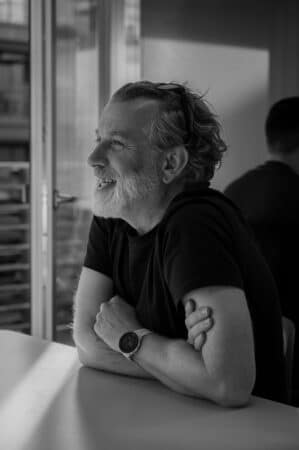
Colin Davis, Director at Studio Partington, a UK-based architecture firm. (Image: Studio Partington)
Davis explains that the firm’s early years in designing competitive market-ready commercial offices gave the firm a competency in rigor foreign to the housing market. “We found that skillset, that sort of rigor, didn’t really exist in developing housing schemes,” he adds. And while the global recession of 2008/2009 decelerated the need for new office space, the United Kingdom continued to have strong demand for new housing.
“We have always been interested in efficiencies in design, so that leads very naturally to sustainability,” says Davis.
Expertise: The Performance Gap
With the downturn in global architecture following the Great Recession, Studio Partington began delivering research and policy writing services for clients. “Because of the depth of knowledge acquired in commercial office buildings,” says Davis, “the policy writers were receptive to our experience in how to put buildings together.”
“One of the first research projects that Richard was involved in explored what has become known as the Performance Gap,” says Davis, explaining that “while the government may set these ambitious targets and architects design for them, energy-model their designs, and have them built after realized and tested, there is this gap.”
The performance gap is between what you expected to achieve and what you actually achieved. But how to understand this gap and why it presents itself despite best intentions would be best directed at one of the firm’s publications, like “Better Buildings: Learning from buildings in use,” published in 2017 and available in the RIBA Bookshop.
“Maybe what sets us apart is our commitment to the first principles of sustainability,” says Davis, and this was also important to the policy writers who hired us. “Everybody in the practice shares an interest in understanding why a regulation or target exists,” he continues, “rather than just taking it at face value that it is the right thing to do.”
Digital Tools: Their Contribution to Leadership
Studio Partington’s preferred digital CAD-BIM platform has remained the same since the firm’s beginning. “We have used Vectorworks for the whole life of the practice,” says Davis, “and it was for one very pragmatic reason: it ran on the Mac.”
“We like the Mac environment, but more specifically, it felt very intuitive to use.”
Davis explains that 25 years ago—long before BIM existed and became normative—what was important to the firm’s leaders was that they selected a CAD tool that enhanced and supported the firm’s particular workflows, processes, and needs.
You can develop and test a massing model very quickly in Vectorworks, which has many advantages.
“We liked the immediacy of Vectorworks. And it felt like a very direct replacement for a drawing board,” he adds. “But the software has grown and matured, and so have we.”
Today the firm is fully proficient in the BIM process. It utilizes the power and efficiency of the BIM model to hold, organize, and extricate data useful to the process of creating aesthetically and performatively successful architecture.
“I do think the ability to capture information graphically is a really great skill for architects to have,” says Davis, “and it’s often missing from research projects where the data might be great, but people haven’t really thought about how it is communicated.” It is here that Davis notes that Vectorworks’ historic strength in graphics capabilities shines for a firm like Studio Partington, where he notes, “our job as architects ultimately is one of communication.”
BIM and Sustainable Design
Davis says that when it comes to the firm’s design process, where leadership in sustainability is paramount, the first step is getting “first principles” executed correctly. This essentially boils down to passive design optimization and how the sun impacts a building’s energy performance and life outside a building.
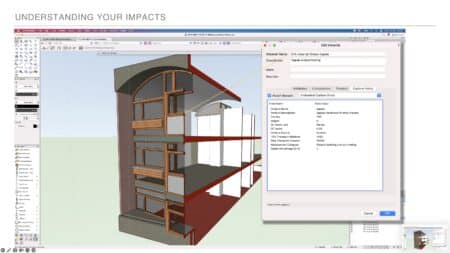
Studio Partington is a full BIM practice that swiftly constructs 3D models in Vectorworks for quick energy analysis feedback and addresses what the firm calls first principles. (Image: Studio Partington)
“You can develop and test a massing model very quickly in Vectorworks, which has many advantages,” he adds, “like using the built-in Helidon Tool for shadow analysis. So, the spaces you have labeled as ‘park’ if you see they don’t get much sunlight, you know immediately you must adjust the design.”
Davis is enthusiastic as he talks about how the firm studies massing models swiftly in Vectorworks, increasing certainty in the critical aspects of design in these areas he calls first principles. Once these are established, the firm will most often produce advanced energy model analysis using PHPP (Passive House Planning Package) tool.
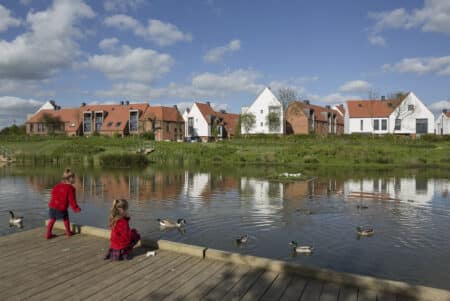
Derwenthorpe is one of the practice’s best-known projects in the UK, a rigorous example of sustainable housebuilding. The development is one of England’s first large-scale low-carbon communities. (Image: Studio Partington)
“We are quite keen on PHPP and are talking to the local [UK] Vectorworks people about integrating PHPP into Vectorworks,” says Davis. Tools like PHPP and the UK-government-sponsored tool SAP, are Excel-based. “We have a good debate in the office about ‘what is a model?’ because if you ask an architect what a model is, they think about a 3D geometry model,” he notes.
Before the BIM transition got underway for most architects in the UK, Davis says, “I had a preconceived vision of what BIM is, but in actuality, it is many other things than just a transparent 3D model with clash detection and things like that.”
Davis says, “a model can exist in many things. A 2D drawing can be a model. An economist will tell you their model is entirely in Excel. I think I am learning a bit about that, like the embodied carbon model—that is just collecting data and saying, ‘what can I now do with this data, how does it inform my design, and what kind of changes do I make?’ “
BIM: From Transition to Beautiful Renderings
Studio Partington has been using Vectorworks since before the BIM phase in AEC began. Like many architects, he acknowledged that the initial thought of adopting the BIM process seemed daunting.
“I suppose what made it much easier was we were already very familiar with the environment of Vectorworks,” he says. Because Vectorworks is a hybrid BIM/CAD software, it has afforded its longest adherents the luxury of transitioning to BIM in a more moderately paced process with more fallback control and less anxiety. “What we started with was what I would call a two-dimensional BIM deliverable, using all the intelligent components with data but not contending ourselves with the third dimension,” says Davis. Once the firm mastered that, adding the third dimension to their workflow was pretty easy.

The Brickyard project in East Ham is currently under construction and showcases the firm’s sustainable design expertise. (Image: Studio Partington)
“We have an external Vectorworks consultant that we work with who helped us establish our CAD standards from an early stage. Our 2D data was very well organized and managed, making the transition to BIM easier. People often ask us about our BIM transition,” he adds, “and I say, ‘don’t even think about that transition to 3D BIM until you have your 2D stuff nailed.’ “
“Now people in the office begin by saying, ‘we are going to get the model built,’ and everything starts from there,” he adds. “They really see efficiencies in delivering their work via that approach, and then you tack on all the value-added benefits like embodied carbon, data visualization, and architectural visualization.”
Embodied Carbon—The Brickyard Project
A great example of Studio Partington’s competencies in leading-edge sustainable design is in the Brickyard Project, a new three-block, mixed-use development in East Ham.
Our 2D data was very well organized and managed, making the transition to BIM easier. People often ask us about our BIM transition, and I say, ‘don’t even think about that transition to 3D BIM until you have your 2D stuff nailed.’
“We actually inherited this project from a better-known design practice,” says Davis, who talks about how Studio Partington took over and was tasked with completing the project. Originally the building was planned to be a CLT (timber-frame) structure, but along with the Grenfell Tower fire and the realization of how the CLT structure would work on top of the concrete frame, the project shifted to an all-concrete frame structure that actually had lower total embodied carbon than the original hybrid CLT and concrete podium design.
“Because of the way CLT works, it drops continuous line loads down through its structure,” says Davis. “And obviously, the concrete frame is working as a frame, a series of columns and slabs. So, the design required very large transfer structures—transferring line loads into frame loads.”
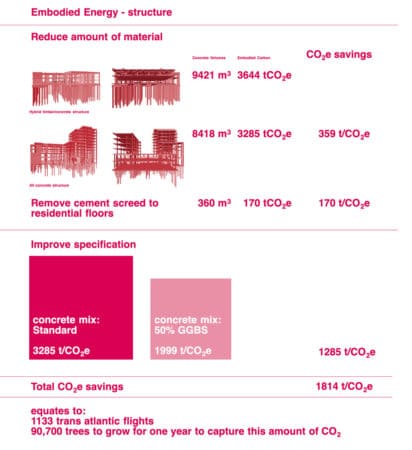
Studio Partington learned that it was possible to design a lighter all-concrete frame than a combined concrete podium and CLT timber frame. The total CO2 saved in this design decision was equal to over 1,000 transatlantic flights. (Image: Studio Partington)
Tasked also with looking at sustainability and carbon efficiency, Davis says his firm realized that they could design a more efficient all-concrete structure. “We started again with the design of a very efficient concrete frame that would work for a residential layout and a retail layout at the lower and ground levels,” he adds. “We found we could design a concrete structure that had less concrete than the hybrid timber-frame and concrete building.”
The results are pretty stunning, equating to reduced embodied carbon equal to 1,133 trans-Atlantic flights.
Final Thoughts: Nullius in Verba and the Road to Expertise
The Brickyard project is a story in intuitive contradiction. It reminds me of the motto of the Royal Society established in 1660: nullius in verba—take nobody’s word for it. Historian Joel Mokyr in his book, A Culture of Growth, attempts to answer the question of why Europe was the first region in the world to industrialize and focuses his answer on critical cultural thought led by such cultural entrepreneurs (his term) as Sir Francis Bacon. But the key is this: the ideas of free debate and free markets—combined constituted a break-away from dogmatic ideologies and a quest for infinite progress based on what Bacon called useful knowledge.
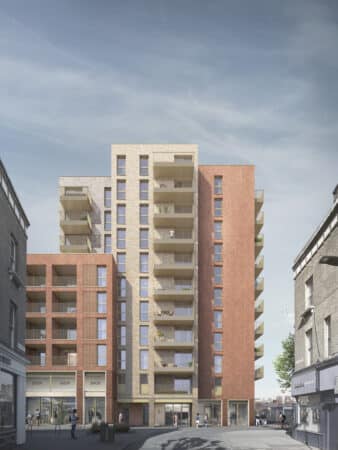
Another rendering view of The Brickyard project. On the courtyard side, there are podium-level gardens with full access to sunlight. (Image: Studio Partington)
Talking to Colin Davis of Studio Partington reminds me of Mokyr’s book, especially of the values placed on freedom to explore new ways of working, the importance of measuring the physical world (embodied carbon), and the systematic approach to developing useful knowledge based on inductive methods.
This gets us back to the performance gap and the firm’s efforts to fully understand how these transpire, what effect they generate on carbon footprints (despite best attempts at sustainable design), and how to combat and close that gap via concentrated research and the application of that research to design.
Nullius in verba—take nobody’s word for it—also applies to the firm’s approach to BIM. “As a rule, I’d say we are not that detailed in our models,” says Davis, who advocates a less ideological approach to BIM. And by ideological, I mean the industry’s controlling viewpoint that getting as much as possible in the BIM model is somehow superior.
We tend to model to what is relevant, say 1:50. But where the model becomes very powerful is being able to interrogate it and understand where the complex junctions are. So, the BIM model gives a very good framework for where the complexity is and how we might handle it.
Davis says scale is relevant, meaning the scale of the drawings. “We tend to model to what is relevant, say 1:50,” he adds. “But where the model becomes very powerful is being able to interrogate it and understand where the complex junctions are. So, the BIM model gives a very good framework for where the complexity is and how we might handle it.” Davis says all of the detailed work is still handled in two dimensions.
Mies used to say, “God is in the details.” For Davis, the details—from the firm’s early start and recognition—have always been the pathway to expertise, recognition, and award-winning work.






Reader Comments
Comments for this story are closed